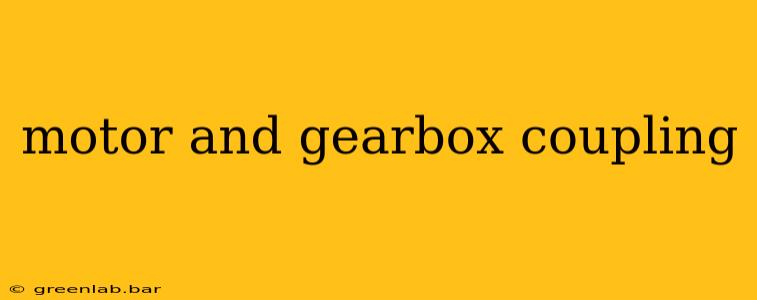Choosing the right coupling between a motor and gearbox is crucial for optimal performance, longevity, and safety of your machinery. This comprehensive guide explores the various types of motor and gearbox couplings, their applications, and the factors to consider when selecting the best fit for your specific needs.
Understanding the Role of Motor and Gearbox Couplings
A motor and gearbox coupling acts as a vital connecting link, transmitting power smoothly from the motor's shaft to the gearbox input shaft. More than just a connection, the coupling serves several critical functions:
- Misalignment Compensation: Motors and gearboxes rarely align perfectly. Couplings absorb minor misalignments (axial, angular, or parallel), preventing stress and damage to the connected shafts.
- Vibration Dampening: Motors and gearboxes can generate vibrations during operation. Couplings effectively reduce these vibrations, extending the lifespan of components and minimizing noise.
- Overload Protection: Some couplings offer overload protection, disconnecting the motor and gearbox in case of unexpected shocks or overloads, preventing damage to the entire system.
- Shock Absorption: Couplings absorb sudden shocks and torque fluctuations, protecting the motor and gearbox from potentially damaging surges.
Types of Motor and Gearbox Couplings
Several types of couplings exist, each with unique characteristics and suitability for different applications. The optimal choice depends on factors like torque requirements, speed, misalignment tolerance, and operating environment.
1. Rigid Couplings
- Description: Rigid couplings provide a direct, rigid connection between the motor and gearbox shafts. They are simple, inexpensive, and offer high torsional stiffness.
- Applications: Suitable for applications requiring high accuracy and precise alignment, where misalignment is minimal.
- Limitations: Not suitable for applications with significant misalignment or vibrations.
2. Flexible Couplings
Flexible couplings offer greater tolerance for misalignment and vibration damping compared to rigid couplings. Several subtypes exist:
-
Jaw Couplings (Clamping Couplings): These couplings use interlocking jaws to transmit torque. They are relatively simple, inexpensive, and can handle moderate misalignment.
-
Beam Couplings: These feature flexible beams that transmit torque while accommodating misalignment. They offer good damping capabilities.
-
Elastomeric Couplings: These utilize elastomeric elements (rubber, polyurethane) to transmit torque and absorb vibrations. They're ideal for applications with significant vibration. Variations include:
- Sleeve Couplings: Simple and cost-effective.
- Spider Couplings: Offer higher torque capacity and better damping.
-
Gear Couplings: These use internal gears to transmit torque. They're robust and can handle high loads and misalignment.
-
Fluid Couplings: These utilize fluid to transfer torque, offering smooth starting and overload protection.
3. Special Purpose Couplings
Specific applications may require specialized couplings:
- Magnetic Couplings: These use magnetic attraction to transmit torque, ideal for applications requiring isolation or where leakage prevention is crucial.
- Universal Joints (Cardan Joints): Used to transmit torque between shafts with significant angular misalignment.
Factors to Consider When Selecting a Coupling
Choosing the right coupling involves careful consideration of several factors:
- Torque Capacity: The coupling must be rated to handle the maximum torque of the motor and the load.
- Speed: The coupling's speed rating must match the motor's operating speed.
- Misalignment: Determine the acceptable level of misalignment (axial, angular, parallel) and choose a coupling that can accommodate it.
- Vibration Damping: The coupling should effectively damp vibrations to reduce noise and extend component life.
- Operating Environment: Consider factors such as temperature, humidity, and corrosive substances.
- Maintenance: Choose a coupling that is easy to maintain and replace.
- Cost: Balance performance requirements with budgetary considerations.
Conclusion
Selecting the appropriate motor and gearbox coupling is critical for reliable and efficient machinery operation. Understanding the various types of couplings and the factors influencing the selection process will enable engineers and technicians to choose the best solution for their specific application, ensuring optimal performance, extended equipment life, and minimal downtime. Consulting manufacturer specifications and seeking expert advice is always recommended for complex applications.

